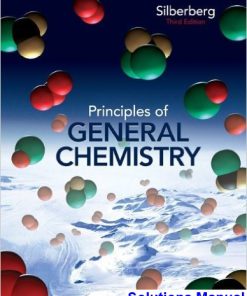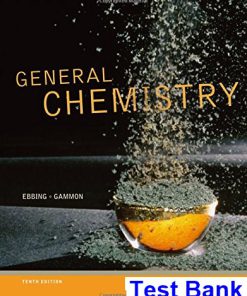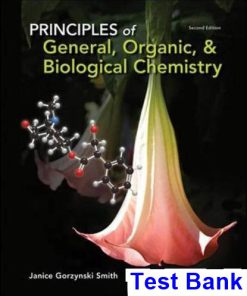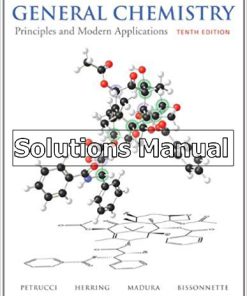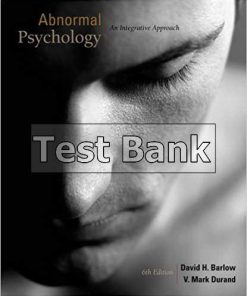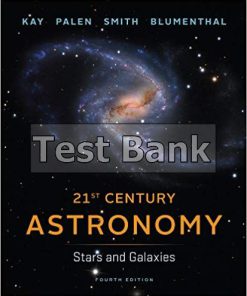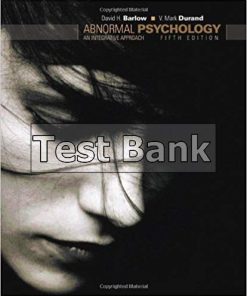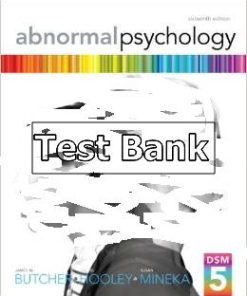General Chemistry Principles and Modern Applications 10th Edition Petrucci Test Bank
$26.50$50.00 (-47%)
General Chemistry Principles and Modern Applications 10th Edition Petrucci Test Bank.
You may also like
-
$26.50
$50.00
General Chemistry Principles and Modern Applications 10th Edition Petrucci Test Bank
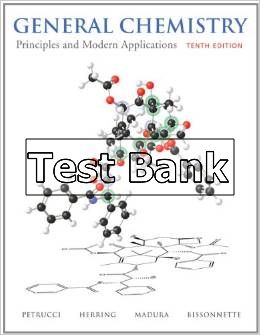
Product details:
- ISBN-10 : 0132064529
- ISBN-13 : 978-0132064521
- Author:
General Chemistry: Principles and Modern Applications, is the most trusted book on the market recognized for its superior problems, lucid writing, and precision of argument and precise and detailed and treatment of the subject. The 11th edition offers enhanced hallmark features, new innovations and revised discussions that that respond to key market needs for detailed and modern treatment of organic chemistry, embracing the power of visual learning and conquering the challenges of effective problem solving and assessment.
Table contents:
1 Matter: Its Properties and Measurement
1(33)
1-1 The Scientific Method
2(2)
1-2 Properties of Matter
4(1)
1-3 Classification of Matter
5(3)
1-4 Measurement of Matter: SI (Metric) Units
8(5)
1-5 Density and Percent Composition: Their Use in Problem Solving
13(5)
1-6 Uncertainties in Scientific Measurements
18(1)
1-7 Significant Figures
19(15)
Summary
23(1)
Integrative Example
24(2)
Exercises
26(3)
Integrative and Advanced Exercises
29(2)
Feature Problems
31(1)
Self-Assessment Exercises
32(2)
2 Atoms and the Atomic Theory
34(34)
2-1 Early Chemical Discoveries and the Atomic Theory
35(3)
2-2 Electrons and Other Discoveries in Atomic Physics
38(4)
2-3 The Nuclear Atom
42(2)
2-4 Chemical Elements
44(4)
2-5 Atomic Mass
48(3)
2-6 Introduction to the Periodic Table
51(3)
2-7 The Concept of the Mole and the Avogadro Constant
54(2)
2-8 Using the Mole Concept in Calculations
56(12)
Summary
59(1)
Integrative Example
59(1)
Exercises
60(4)
Integrative and Advanced Exercises
64(1)
Feature Problems
65(1)
Self-Assessment Exercises
66(2)
3 Chemical Compounds
68(43)
3-1 Types of Chemical Compounds and Their Formulas
69(4)
3-2 The Mole Concept and Chemical Copmpunds
73(3)
3-3 Composition of Chemical Compounds
76(8)
3-4 Oxidation States: A Useful Tool in Decribing Chemical Compounds
84(2)
3-5 Naming Compounds: Organic and Inorganic Compunds
86(1)
3-6 Names and Formulas of Inorganic Compounds
87(7)
3-7 Names and Formulas of Organic Compunds
94(17)
Summary
100(1)
Integrative Example
101(2)
Exercises
103(4)
Integrative and Advanced Exercises
107(1)
Feature Problems
108(2)
Self-Asessment Exercises
110(1)
4 Chemical Reactions
111(40)
4-1 Chemical Reactions and Chemical Equations
112(4)
4-2 Chemical Equations and Stoichiometry
116(7)
4-3 Chemical Reactions in Solution
123(6)
4-4 Determining the Limiting Reactant
129(3)
4-5 Other Practical Matters in Reaction Stoichiometry
132(19)
Summary
138(1)
Integrative Example
139(1)
Exercises
140(8)
Feature Problems
148(1)
Self-Assessment Exercises
149(2)
5 Introduction the Reactions in Aqueous Solutions
151(41)
5-1 The Nature of Aqueous Solutions
152(4)
5-2 Precipitation Reactions
156(4)
5-3 Acid-Base Reactions
160(5)
5-4 Oxidation-Reduction Reactions: Some General Principles
165(5)
5-5 Balancing Oxidation-Reduction Equations
170(5)
5-6 Oxidizing and Reducing Agents
175(2)
5-7 Stoichiometry of Reactions in Aqueous Solutions: Titrations
177(15)
Summary
181(1)
Integrative Example
182(1)
Exercises
183(4)
Integrative and Advanced Exercises
187(2)
Feature Problems
189(2)
Self-Asessment Exercises
191(1)
6 Gases
192(49)
6-1 Properties of Gases: Gas Pressure
193(5)
6-2 The Simple Gas Laws
198(6)
6-3 Combining the Gas Laws: The Ideal Gas Equation and the General Gas Equation
204(3)
6-4 Applications of the Ideal Gas Equation
207(3)
6-5 Gases in Chemical Reactions
210(2)
6-6 Mixtures of Gases
212(4)
6-7 Kinetic-Molecular Theory of Gases
216(7)
6-8 Gas Properties Relating to the Kinetic-Molecular Theory
223(3)
6-9 Nonideal (Real) Gases
226(15)
Summary
229(1)
Integrative Example
230(1)
Exercise
231(5)
Integrative and Advanced Exercises
236(2)
Feature Problems
238(2)
Self-Assessment Exercises
240(1)
7 Thermochemistry
241(53)
7-1 Getting Started: Some Terminology
242(2)
7-2 Heat
244(4)
7-3 Heats of Reaction and Calorimetry
248(4)
7-4 Work
252(3)
7-5 The First Law of Thermodynamic
255(4)
7-6 Heats of Reaction: &U and &H
259(7)
7-7 Indirect Determination of &H: Hess’s Law
266(2)
7-8 Standard Enthalpies of Formation
268(7)
7-9 Fuels as Sources of Energy
275(19)
Summary
281(1)
Integrative Example
282(1)
Exercises
283(6)
Integrative and Advanced Exercises
289(2)
Feature Problems
291(1)
Self-Assessment Exercises
292(2)
8 Electrons in Atoms
294(66)
8-1 Electromagnetic Radiation
295(5)
8-2 Atomic Spectra
300(2)
8-3 Quantum Theory
302(5)
8-4 The Bohr Atom
307(6)
8-5 Two Ideas Leading to a New Quantum Mechanics
313(2)
8-6 Wave Mechanics
317(7)
8-7 Quantum Numbers and Electron Orbitals
324(3)
8-8 Interpreting and Representing the Orbitals of the Hydrogen Atom
327(6)
8-9 Electron Spin: A Fourth Quantum Number
333(3)
8-10 Multielectron Atoms
336(3)
8-11 Electron Configurations
339(5)
8-12 Electron Configurations and the Periodic Table
344(16)
Summary
348(1)
Integrative Example
349(2)
Exercises
351(6)
Integrative and Advanced Exercises
357(1)
Feature Problems
358(1)
Self-Assessment Exercises
359(1)
9 The Periodic Table and Some Atomic Properties
360(35)
9-1 Classifying the Elements: The Periodic Law and the Periodic Table
361(3)
9-2 Metals and Nonmetals and Their lons
364(3)
9-3 Sizes of Atoms and Ions
367(7)
9-4 Ionization Energy
374(4)
9-5 Electron Affinity
378(1)
9-6 Magnetic Properties
379(2)
9-7 Periodic Properties of the Elements
381(14)
Summary
386(1)
Integrative Example
386(3)
Exercises
389(2)
Integrative and Advanced Exercises
391(1)
Feature Problems
392(1)
Self-Assessment Exercises
393(2)
10 Chemical Bonding I: Basic Concepts
395(54)
10-1 Lewis Theory: An Overview
396(3)
10-2 Covalent Bonding: An Introduction
399(3)
10-3 Polar Covalent Bonds and Electrostatic Potential Maps
402(6)
10-4 Writing Lewis Structures
408(8)
10-5 Resonance
416(2)
10-6 Exceptions to the Octet Rule
418(3)
10-7 Shapes of Molecules
421(12)
10-8 Bond Order and Bond Lengths
433(1)
10-9 Bond Energies
434(15)
Summary
438(1)
Integrative Example
439(1)
Exercises
440(6)
Integrative and Advanced Exercises
446(1)
Feature Problems
447(1)
Self-Assessment Exercises
448(1)
11 Chemical Bonding II: Additional Aspects
449(49)
11-1 What a Bonding Theory Should Do
450(1)
11-2 Introduction to the Valence-Bond Method
451(2)
11-3 Hybridization of Atomic Orbitals
453(8)
11-4 Multiple Covalent Bonds
461(4)
11-5 Molecular Orbital Theory
465(9)
11-6 Delocalized Electrons: Bonding in the Benzene Molecule
474(6)
11-7 Bonding in Metals
480(4)
11-8 Some Unresolved Issues: Can Electron Charge-Density Plots Help?
484(14)
Summary
489(1)
Integrative Example
489(2)
Exercises
491(3)
Integrative and Advanced Exercises
494(1)
Feature Problems
495(2)
Self-Assessment Exercises
497(1)
12 Intermolecular Forces: Liquids and Solids
498(59)
12-1 Intermolecular Forces
499(9)
12-2 Some Properties of Liquids
508(12)
12-3 Some Properties of Solids
520(2)
12-4 Phase Diagrams
522(4)
12-5 Network Covalent Solids and Ionic Solids
526(4)
12-6 Crystal Structures
530(12)
12-7 Energy Changes in the Formation of Ionic Crystals
542(15)
Summary
545(1)
Integrative Example
546(1)
Exercises
547(5)
Integrative and Advanced Exercises
552(2)
Feature Problems
554(2)
Self-Assessment Exercises
556(1)
13 Solutions and Their Physical Properties
557(45)
13-1 Types of Solutions: Some Terminology
558(1)
13-2 Solution Concentration
558(4)
13-3 Intermolecular Forces and the Solution Process
562(5)
13-4 Solution Formation and Equilibrium
567(3)
13-5 Solubilities of Gases
570(3)
13-6 Vapor Pressures of Solutions
573(4)
13-7 Osmotic Pressure
577(4)
13-8 Freezing-Point Depression and Boiling-Point Elevation of Nonelectrolyte Solutions
581(3)
13-9 Solutions of Electrolytes
584(3)
13-10 Colloidal Mixtures
587(15)
Summary
590(1)
Integrative Example
591(1)
Exercises
592(5)
Integrative and Advanced Exercises
597(2)
Feature Problems
599(1)
Self-Assessment Exercises
600(2)
14 Chemical Kinetics
602(63)
14-1 The Rate of a Chemical Reaction
603(2)
14-2 Measuring Reaction Rates
605(3)
14-3 Effect of Concentration on Reaction Rates: The Rate Law
608(3)
14-4 Zero-Order Reactions
611(1)
14-5 First-Order Reactions
612(7)
14-6 Second-Order Reactions
619(1)
14-7 Reaction Kinetics: A Summary
620(2)
14-8 Theoretical Models for Chemical Kinetics
622(4)
14-9 The Effect of Temperature on Reaction Rates
626(3)
14-10 Reaction Mechanisms
629(8)
14-11 Catalysis
637(28)
Summary
642(1)
Integrative Example
643(2)
Exercises
645(5)
Integrative and Advanced Exercises
650(2)
Feature Problems
652(2)
Self-Assessment Exercises
654(11)
15 Principles of Chemical Equilibrium
665(32)
15-1 Dynamic Equilibrium
656(7)
15-2 The Equilibrium Constant Expression
663(6)
15-3 Relationships Involving Equilibrium Constant
669(1)
15-4 The Magnitude of an Equilibrium Constant
669(1)
15-5 The Reaction Quotient, Q: Predicting the Direction of Net Change
670(3)
15-6 Altering Equilibrium Conditions: Le Chatelier’s Principle
673(6)
15-7 Equilibrium Calculations: Some Illustrative Examples
679(18)
Summary
686(1)
Integrative Example
686(2)
Exercises
688(5)
Integrative and Advanced Exercises
693(1)
Feature Problems
694(1)
Self-Assessment Exercises
695(2)
16 Acids and Bases
697(48)
16-1 Arrhenius Theory: A Brief Review
698(1)
16-2 Brønsted-Lowry Theory of Acids and Bases
698(5)
16-3 Self-Ionization of Water and the pH Scale
703(3)
16-4 Strong Acids and Strong Bases
706(2)
16-5 Weak Acids and Weak Bases
708(9)
16-6 Polyprotic Acids
717(6)
16-7 Ions as Acids and Bases
723(4)
16-8 Molecular Structure and Acid-Base Behavior
727(5)
16-9 Lewis Acids and Bases
732(13)
Summary
736(1)
Integrative Example
736(2)
Exercises
738(4)
Integrative and Advanced Exercises
742(1)
Feature Problems
743(1)
Self-Assessment Exercises
744(1)
17 Additional Aspects of Acid-Base Equilibria
745(39)
17-1 Common-Ion Effect in Acid-Base Equilibria
746(4)
17-2 Buffer Solutions
750(9)
17-3 Acid-Base Indicators
759(3)
17-4 Neutralization Reactions and Titration Curves
762(8)
17-5 Solutions of Salts of Polyprotic Acids
770(1)
17-6 Acid-Base Equilibrium Calculations: A Summary
771(13)
Summary
773(1)
Integrative Example
773(2)
Exercises
775(4)
Integrative and Advanced Exercises
779(3)
Feature Problems
782(1)
Self-Assessment Exercises
783(1)
18 Solubility and Complex-Ion Equilibria
784(35)
18-1 Solubility Product Constant, Ksp
785(1)
18-2 Relationship Between Solubility and Ksp
786(2)
18-3 Common-Ion Effect in Solubility Equilibria
788(2)
18-4 Limitations of the Ksp Concept
790(2)
18-5 Criteria for Precipitation and Its’ Comleteness
792(3)
18-6 Fractional Precipitation
795(2)
18-7 Solubility and pH
797(2)
18-8 Equilibria Involving Complex Ions
799(6)
18-9 Qualitative Cation Analysis
805(14)
Summary
810(1)
Integrative Example
810(2)
Exercises
812(3)
Integrative and Advanced Exercises
815(1)
Feature Problems
816(1)
Self-Assessment Exercises
817(2)
19 Spontaneous Change: Entropy and Gibbs Energy
819(44)
19-1 Spontaneity: The Meaning of Spontaneous Change
820(1)
19-2 The Copncept of Etropy
821(6)
19-3 Evaluating Entropy and Entropy Changes
827(5)
19-4 Criteria for Spontaneous Change: the Second Law of Thermodynamics
832(4)
19-5 Standard Gibbs Energy Change, &G°
836(1)
19-6 Gibbs Energy Change and Equilibrium
837(11)
19-7 &G° and K as Functions of Temperature
848(3)
19-8 Coupled Ractions
851(12)
Summary
852(1)
Integrative Example
853(1)
Exercises
854(4)
Integrative and Advanced Exercises
858(2)
Feature Problems
860(1)
Self-Assessment Exercises
861(2)
20 Electrochemistry
863(54)
20-1 Electrode Potentials and Their Measurement
864(5)
20-2 Standard Electrode Potentials
869(5)
20-3 Ecell. DeltaG, and K
874(6)
20-4 Ecell as a Function of Concentrations
880(8)
20-5 Batteries: Producing Electricity Through Chemical Reactions
888(6)
20-6 Corrosion: Unwanted Voltaic Cell
894(2)
20-7 Electrolysis: Causing Nonspontaneous Reactions to Occur
896(4)
20-8 Industrial Electrolysis Processes
900(17)
Summary
904(1)
Integrative Example
905(2)
Exercises
907(5)
Integrative and Advanced Exercises
912(2)
Feature Problems
914(1)
Self-Assessment Exercises
915(2)
21 Chemistry of the Main-Group Elements I: Groups 1, 2, 13, and 14
917(59)
21-1 Periodic Trends and Charge Density
918(2)
21-2 Group 1: The Alkali Metals
920(13)
21-3 Group 2: The Alkaline Earth Metals
933(8)
21-4 Group 13: The Boron Family
941(10)
21-5 Group 14: The Carbon Family
951(25)
Summary
968(1)
Integrative Example
969(1)
Exercises
970(2)
Integrative and Advanced Exercises
972(2)
Feature Problems
974(1)
Self-Assessment Exercises
974(2)
22 Chemistry of the Main-Group Elements II: Groups 18, 17, 16, 15, and Hydrogen
976(55)
22-1 Periodic Trends in Bonding
977(2)
22-2 Group 18: The Noble Gases
979(6)
22-3 Group 17: The Halogens
985(9)
22-4 Group 16: The Oxygen Family
994(10)
22-5 Group 15: The Nitrogen Family
1004(13)
22-6 Hydrogen: A Unique Element
1017(14)
Summary
1021(1)
Integrative Example
1022(1)
Exercises
1023(3)
Integrative and Advanced Exercises
1026(2)
Feature Problems
1028(1)
Self-Assessment Exercises
1029(2)
23 The Transition Elements
1031(38)
23-1 General Properties
1032(5)
23-2 Principles of Extractive Metallurgy
1037(7)
23-3 Metallurgy of Iron and Steel
1044(2)
23-4 First-Row Transition Metal Elements: Scandium to Manganese
1046(6)
23-5 The Iron Triad: Iron, Cobalt, and Nickel
1052(2)
23-6 Grup 11: Copper, Silver, and Gold
1054(2)
23-7 Group 12: Zinc, Cadmium, and Mercury
1056(3)
23-8 Lanthanides
1059(1)
23-9 High-Temperature Superconductors
1059(10)
Summary
1062(1)
Integrative Example
1062(1)
Exercises
1063(3)
Integrative and Advanced Exercises
1066(1)
Feature Problems
1067(1)
Self-Assessment Exercises
1068(1)
24 Complex Ions and Coordination Compounds
1069(42)
24-1 Werner’s Theory of Coordination Compounds: An Overview
1070(2)
24-2 Ligands
1072(3)
24-3 Nomenclature
1075(1)
24-4 Isomerism
1076(7)
24-5 Bonding in Complex Ions: Crystal Field Theory
1083(5)
24-6 Magnetic Properties of Coordination Compounds and Crystal Field Theory
1088(2)
24-7 Color and the Colors of Complexes
1090(3)
24-8 Aspects of Complex-Ion Equilibria
1093(2)
24-9 Acid-Base Reactions of Complex Ions
1095(1)
24-10 Some Kinetic Considerations
1096(1)
24-11 Applications of Coordination Chemistry
1097(14)
Summary
1102(1)
Integrative Example
1103(1)
Exercises
1104(2)
Integrative and Advanced Exercises
1106(2)
Feature Problems
1108(1)
Self-Assessment Exercises
1109(2)
25 Nuclear Chemistry
1111(36)
25-1 Radioactivity
1112(3)
25-2 Naturally Occuring Radioactive Isotopes
1115(2)
25-3 Nuclear Reactions and Artificially Induced Radioactivity
1117(1)
25-4 Transuranium Elements
1118(1)
25-5 Rate of Radioactive Decay
1119(6)
25-6 Energetics of Nuclear Reactions
1125(3)
25-7 Nuclear Stability
1128(2)
25-8 Nuclear Fission
1130(3)
25-9 Nuclear Fusion
1133(1)
25-10 Effect of Radiation on Matter
1134(3)
25-11 Applications of Radioisotopes
1137(2)
Summary
1139(1)
Integrative Example
1140(1)
Exercises
1141(3)
Integrative and Advanced Exercises
1144(1)
Feature Problems
1145(1)
Self-Assessment Exercises
1146(1)
26 Structures of Organic Compounds
1147(61)
26-1 Organic Compounds and Structures: An Overview
1148(7)
26-2 Alkanes
1155(6)
26-3 Cycloalkanes
1161(7)
26-4 Stereoisomerism in Organic compounds
1168(7)
26-5 Alkenes and Alkynes
1175(4)
26-6 Aromatic Hydrocarbons
1179(2)
26-7 Organic Compound Containing Functional Groups
1181(11)
26-8 From Molecular Formula to Molecular Structure
1192(16)
Summary
1195(2)
Integrative Example
1197(1)
Exercises
1198(6)
Integrative and Advanced Exercises
1204(1)
Feature Problem
1205(2)
Self-Assessment Exercises
1207(1)
27 Reactions of Organic Compounds
1208(58)
27-1 Organic Reactions: An Introduction
1209(2)
27-2 Introduction to Nucleophilic Substitution Reactions
1211(14)
27-3 Introduction to Elimination Reactions
1225(9)
27-4 Reactions of Alcohols
1234(5)
27-5 Introduction to Addition Reactions: Reactions of Alkenes
1239(5)
27-6 Electrophilic Aromatic Substitution
1244(4)
27-7 Reactions of Alkanes
1248(2)
27-8 Polymers and Polymerization Reactions
1250(4)
27-9 Synthesis of Organic Compounds
1254(12)
Summary
1256(1)
Integrative Example
1257(2)
Exercises
1259(4)
Integrative and Advanced Exercises
1263(1)
Feature Problem
1264(1)
Self-Assessment Exercises
1265(1)
28 Chemistry of the Living State
1266(1)
28-1 Chemical Structure of Living Matter: An Overview
1267(1)
28-2 Lipids
1268(3)
28-3 Carbohydrates
1271(8)
28-4 Proteins
1279(7)
28-5 Aspects of Metabolism
1286(6)
28-6 Nucleic Acids
1292(3)
Summary
1295(1)
Integrative Example
1296(1)
Exercises
1297(3)
Integrative and Advanced Exercises
1300(1)
Feature Problems
1301(1)
Self-Assessment Exercises
1302
Appendices
A Mathematical Operations
1(10)
B Some Basic Physical Concepts
11(4)
C SI Units
15(2)
D Data Tables
17(20)
E Concept Maps
37(2)
F Glossary
39(16)
G Answers to Concept Assessment Questions
55
Photo Credits
1(1)
Index
People also search:
General Chemistry Principles and Modern Applications 10th
General Chemistry Principles and Modern Applications 10th edition
General Chemistry Principles and Modern Applications 10th pdf
General Chemistry Principles and Modern Applications 10th pdf free
General Chemistry Principles and Modern Applications 10th download scribd
General Chemistry Principles and Modern Applications 10th pdf download free

